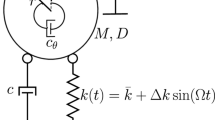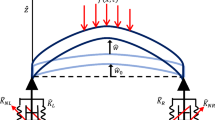Abstract
This study is devoted to the issues of controllability and optimization of oscillatory motions of dynamic systems with distributed parameters. The longitudinal displacements of a thin rectilinear elastic rod are considered. Based on the method of integrodifferential relations proposed by the authors, a generalized formulation of the initial-boundary value problem is given, the solution of which is sought with respect to the kinematic and dynamic variables in a Sobolev energy space. For the case of a uniform rod controlled by external forces applied at both ends, the critical time for which the system can be brought to the rest is determined and the impossibility for arbitrary initial conditions of bringing the points of the rod to the zero state is shown. For fixed time intervals longer than the critical one, the problem is posed to optimally bring the system to the zero state. In this case, the minimized functional is the mean mechanical energy stored in the rod during motion. It is shown that using the d’Alembert representation (in the form of traveling waves), taking into account the properties of the generalized solution, the two-dimensional in space and time control problem is reduced to the classical one-dimensional quadratic variational problem with fixed ends, which is specified with respect to two unknown d’Alembert functions. Using the methods of the calculus of variations, the optimal control and the corresponding motion of the rod are found explicitly. The dependence of the mean energy stored in the system on the control time is analyzed.












Similar content being viewed by others
REFERENCES
J. L. Lions, Optimal Control of Systems Governed by Partial Differential Equations (Springer, Berlin, 1971).
A. G. Butkovsky, Distributed Control Systems (Elsevier, New York, 1969).
N. U. Ahmed and K. L. Teo, Optimal Control of Distributed Parameter Systems (North-Holland, Amsterdam, 1981).
W. Krabs, Optimal Control of Undamped Linear Vibrations (Heldermann, Lemgo, 1995).
J. E. Lagnese, G. Leugering, and E. J. P. G. Schmidt, Modeling, Analysis and Control of Dynamic Elastic Multi-Link Structures (Birkhäuser, Boston, 1984).
G. Leugering, “A domain decomposition of optimal control problems for dynamic networks of elastic strings,” Comput. Optimiz. Appl. 16, 5–29 (2000).
M. Gugat, “Optimal control of networked hyperbolic systems: Evaluation of derivatives,” Adv. Model. Optimiz. 7, 9–37 (2005).
S. P. Banks, State-Space and Frequency-Domain Methods in the Control of Distributed Parameter Systems (Peregrinus, London, 1983).
R. F. Curtain and H. J. Zwart, An Introduction to Infinite-Dimensional Linear Systems Theory (Springer, New York, 1995).
F. L. Chernousko, “Control of elastic systems by bounded distributed forces,” Appl. Math. Comput. 78, 103–110 (1996).
M. Gerdts, G. Greif, and H. J. Pesch, “Numerical optimal control of the wave equation: Optimal boundary control of a string to rest in finite time,” Math. Comput. Simul. 79, 1020–1032 (2008).
A. I. Ovseevich and A. K. Fedorov, “Asymptotically optimal control for a simplest distributed system,” Dokl. Math. 95, 194–197 (2017).
I. V. Romanov and A. S. Shamaev, “On the problem of precise control of the system obeying the delay string equation,” Autom. Remote Control 74, 1810 (2013).
I. V. Romanov and A. S. Shamaev, “On a boundary controllability problem for a system governed by the two-dimensional wave equation,” J. Comput. Syst. Sci. Int. 58, 105 (2019).
R. W. Lewis, P. Nithiarasu, and K. N. Seetharamu, Fundamentals of the Finite Element Method for Heat and Fluid Flow (Wiley, Chichester, 2004).
M. J. Balas, “Finite-dimensional control of distributed parameter systems by galerkin approximation of infinite dimensional controllers,” J. Math. Anal. Appl. 114, 17–36 (1986).
P. D. Christofides, Nonlinear and Robust Control of PDE Systems: Methods and Applications to Transport-Reaction Processes (Birkhäuser, Boston, 2001).
T. Belytschko, Y. Y. Lu, and L. Gu, “Element-free Galerkin method,” Int. J. Numer. Methods Eng. 37, 229–256 (1994).
S. N. Atluri and T. Zhu, “A new meshless local Petrov-Galerkin (MLPG) approach in computational mechanics,” Comput. Mech. 22, 117–127 (1998).
P. B. Bochev and M. D. Gunzburger, Least-Squares Finite Element Methods (Springer, New York, 2009).
L. D. Akulenko and A. A. Gavrikov, “Controlling the one-dimensional motion of hybrid vibrational rod systems,” J. Comput. Syst. Sci. Int. 57, 349 (2018).
G. V. Kostin and V. V. Saurin, Dynamics of Solid Structures. Methods Using Integrodifferential Relations (De Gruyter, Berlin, 2018).
G. V. Kostin, “Modelling and optimization of controlled longitudinal motions for an elastic rod based on the Ritz method,” in Proceedings of the 14th International Conference on Stability and Oscillations of Nonlinear Control Systems (Pyatnitskiy’s Conference) STAB (IEEE, Moscow, 2018), pp. 1–4. https://doi.org/10.1109/STAB.2018.8408369
G. Kostin, “Verified solution to optimal control problems of elastic rod motion based on the Ritz method,” Acta Cybern. 24, 393–408 (2020). https://doi.org/10.14232/actacyb.24.3.2020.7
V. A. Il’in and E. I. Moiseev, “Optimization of boundary controls of string vibrations,” Russ. Math. Surv. 60, 1093 (2005).
E. I. Moiseev and A. A. Frolov, “Boundary control of string vibrations in a subcritical time under a medium resistance at the right end,” Differ. Equations 55, 541 (2019).
M. Gugat, Optimal Boundary Control and Boundary Stabilization of Hyperbolic Systems (Springer, Berlin, 2015).
M. Gugat, E. Trelat, and E. Zuazua, “Optimal Neumann control for the 1D wave equation: Finite horizon, infinite horizon, boundary tracking terms and the turnpike property,” Syst. Control Lett. 90, 61–70 (2016).
C. Schwab, P- and hp- Finite Element Methods: Theory and Applications in Solid and Fluid Mechanics. Numerical Mathematics and Scientific Computation (Oxford Univ. Press, New York, 1998).
A. N. Tikhonov and A. A. Samarskii, Equations of Mathematical Physics (Nauka, Moscow, 1977; Dover, New York, 2011)
S. G. Mikhlin, Course of Mathematical Physics (Nauka, Moscow, 1968) [in Russian].
K. Yoshida, Functional Analysis (Springer, Berlin, 1965).
M. Giaquinta and S. Hildebrandt, Calculus of Variations. I (Springer, Berlin, 2004).
Funding
This study was supported by a state assignment (state registration number AAAA-A20-120011690138-6) and was partially financially supported by the Russian Foundation for Basic Research (grant nos. 19-01-00173 and 21-51-12004).
Author information
Authors and Affiliations
Corresponding author
Rights and permissions
About this article
Cite this article
Gavrikov, A.A., Kostin, G.V. Optimal Control of Longitudinal Motion of an Elastic Rod Using Boundary Forces. J. Comput. Syst. Sci. Int. 60, 740–755 (2021). https://doi.org/10.1134/S1064230721050099
Received:
Revised:
Accepted:
Published:
Issue Date:
DOI: https://doi.org/10.1134/S1064230721050099




